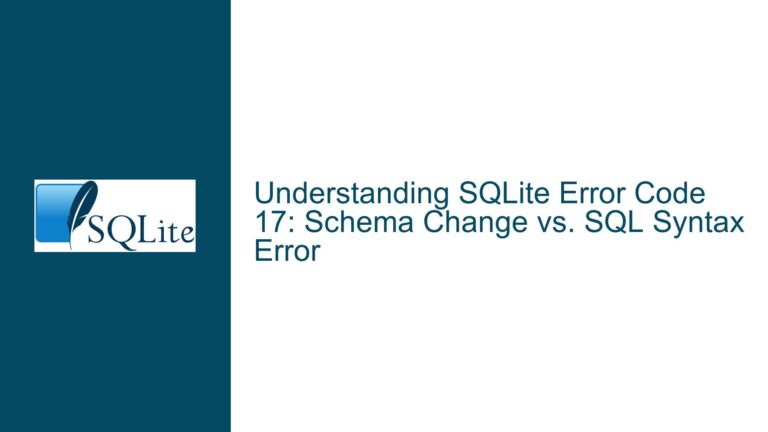Resolving Syntax Errors and Logical Missteps in SQLite NOT EXISTS with EXCEPT Queries
Issue Overview: Syntax Error Near "(" and Structural Flaws in NOT EXISTS with EXCEPT Query
The core issue revolves around a malformed SQL query that combines NOT EXISTS with an EXCEPT clause, resulting in a syntax error near the parenthesis (. The error arises from improper syntax placement, incorrect use of compound operators, and logical misalignment in subquery construction. The query attempts to retrieve students who have not enrolled in sections taught by a specific instructor during certain years, but structural flaws prevent its execution.
Root Causes: Misplaced Syntax, Invalid Compound Query Structure, and Ambiguous Subquery Logic
1. Extraneous Comma in the EXCEPT Subquery Table Reference
The subquery SELECT SectionNo FROM GradeReport G, WHERE G.StudentNo = S.StudentNo contains a syntax-breaking comma after the table alias GradeReport G. In SQLite, the FROM clause requires commas only to separate multiple tables or joins, not after the last table reference. This comma creates an invalid token before the WHERE clause, triggering the immediate syntax error.
2. Parenthesis Mismatch and Incorrect Compound Operator Scope
The EXCEPT operator is a compound query operator that must combine two standalone SELECT statements. However, the original query places EXCEPT within the NOT EXISTS subquery without proper encapsulation. The parentheses around the EXCEPT subquery are misplaced, causing the parser to interpret the EXCEPT as part of the outer query rather than the NOT EXISTS condition. Additionally, the closing parenthesis after (Year = 2018 OR Year = 2019) prematurely terminates the NOT EXISTS subquery, leaving the EXCEPT clause orphaned.
3. Column Count Mismatch in Compound Query Projections
While the immediate syntax error is resolved by fixing the comma, the EXCEPT operator requires both its left and right operands to return the same number of columns. The first subquery (SELECT SectionNo FROM Section WHERE Instructor = 'Clark'...) and the second subquery (SELECT SectionNo FROM GradeReport...) both project one column (SectionNo), so this is not the direct cause of the error. However, improper nesting could lead to mismatches in more complex scenarios.
Resolution: Correcting Syntax, Restructuring Subqueries, and Aligning Logical Intent
Step 1: Eliminate the Extraneous Comma in the EXCEPT Subquery
Rewrite the problematic FROM clause in the EXCEPT subquery:
SELECT SectionNo FROM GradeReport G WHERE G.StudentNo = S.StudentNo
Removing the comma after GradeReport G resolves the immediate syntax error.
Step 2: Reparenthesize the NOT EXISTS and EXCEPT Clauses
The NOT EXISTS clause must encapsulate the entire compound query. Move the EXCEPT inside the NOT EXISTS subquery and adjust parentheses:
SELECT Studentno, Name, dept
FROM Student s
WHERE NOT EXISTS (
(SELECT SectionNo FROM Section WHERE Instructor = 'Clark' AND (Year = 2018 OR Year = 2019))
EXCEPT
(SELECT SectionNo FROM GradeReport G WHERE G.StudentNo = S.StudentNo)
)
This ensures the EXCEPT operates on the two subqueries within the NOT EXISTS context.
Step 3: Validate Column Alignment and Logical Intent
Confirm that both sides of the EXCEPT return compatible columns. Here, SectionNo is used in both subqueries, so the count matches. However, the logic may not align with the original intent. The query as written checks for students where all sections taught by Clark in 2018/2019 have been taken by the student (since NOT EXISTS returns true only if the EXCEPT result is empty). If the goal is to find students who have not taken any of Clark’s sections, a different approach (e.g., NOT IN) would be more appropriate.
Step 4: Optimize for Readability and Performance
- Use explicit
JOINsyntax instead of comma-separated tables:SELECT SectionNo FROM GradeReport G INNER JOIN Student s ON G.StudentNo = s.StudentNo - Add indexes on
GradeReport(StudentNo)andSection(Instructor, Year)to speed up subqueries.
Alternative Approach: Using LEFT JOIN and NULL Checks
If the EXCEPT logic proves counterintuitive, rephrase the query to find students lacking a matching enrollment:
SELECT s.Studentno, s.Name, s.dept
FROM Student s
WHERE NOT EXISTS (
SELECT 1
FROM Section
LEFT JOIN GradeReport G ON G.SectionNo = Section.SectionNo AND G.StudentNo = s.StudentNo
WHERE Section.Instructor = 'Clark'
AND (Section.Year = 2018 OR Section.Year = 2019)
AND G.SectionNo IS NULL
)
This identifies students where no unenrolled sections taught by Clark exist.
Final Query and Validation
The corrected query, incorporating all fixes:
SELECT Studentno, Name, dept
FROM Student s
WHERE NOT EXISTS (
(SELECT SectionNo FROM Section WHERE Instructor = 'Clark' AND (Year = 2018 OR Year = 2019))
EXCEPT
(SELECT SectionNo FROM GradeReport G WHERE G.StudentNo = s.StudentNo)
)
Key Takeaways:
- Syntax precision is critical—minor tokens like commas can derail entire queries.
- Compound operators (
EXCEPT,UNION,INTERSECT) require balanced column counts and careful scoping within subqueries. - Always validate the logical intent against SQL’s set-based semantics to avoid subtle bugs.






